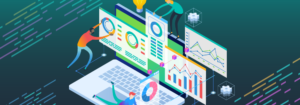The healthcare industry has been in a constant state of flux. From the rise in connected health devices to the transition from fee-for-service to value-based care. The solution to understanding and achieving these rising trends is through big data and analytics. Our predictive analytics scientist, Virginia Long recently contributed to and was featured in two leading healthcare IT publications about the potential of big data and analytics.
Within the Becker’s Health IT & CIO piece, Virginia offered best practices that healthcare organizations can follow to make the most of their resources. Here are a few key takeaways:
“To ensure a successful transition and properly address roadblocks, healthcare organizations must establish a defined data repository and platform to properly store, view and manipulate information. Once the proper platforms are in place, mechanisms and tools need to be utilized, like analytics, to benchmark and track organizational progress. Although costly and time consuming, this is the building block that is fundamental to creating a data-driven approach to healthcare.”
The Healthcare IT News piece, penned by Mike Miliard, took the concept of analytics a step further by highlighting the insights derived from analytics to identify gaps in care, social determinants, etc. Here are a few key takeaways from his piece:
“One of Long’s current focuses is on using geospatial information to find gaps in access to care. For instance, she examined childhood obesity in Mississippi, mapping where there were rural health clinical by county, even by ZIP code. And one ZIP code had a tremendously high rate.
‘You can imagine that if you took that information and added a clinic or state program there it would be super valuable,’ Long explained. ‘You might be able to make some big changes with just a small addition.’
Another of Long’s recent focuses at MedeAnalytics is the addition of geospatial information to help add ‘another layer of understanding to data. ‘Knowing where a person is gives you a lot more relevant information to help you know what’s going on with the patient,’ she said. ‘Not just their health outcomes, but what the drivers are for those health outcomes.’”
To learn more, check out the entire articles at Becker’s Health IT & CIO Review piece and Healthcare IT News piece.
Get our take on industry trends
Gamification in healthcare only works if you can measure it – here’s how
In business and in sports, it’s all about teams. What teams can accomplish when they work together. How they can fail spectacularly when they do
Read on...Pandemic fuels 2021 healthcare megatrends
When I wrote about megatrends last year, the predictions were, naturally, forward-looking. Telehealth, for example, was important because of increased healthcare consumerism and the convergence of technologies to make its use quick and easy for payers, providers and patients.
Read on...Measuring provider cost and utilization
No matter the time of year, payers and providers should work to agree on a shared source of truth when it comes to data. With the recent end of the year, it’s time to celebrate the new year (who isn’t ready to say goodbye to 2020?) and close the books, which includes the reconciliation of any shared savings or losses.
Read on...Data visualization: A picture is worth a thousand…healthcare data points?
The amount of data produced daily has grown exponentially with nearly 90% of the world’s data generated in the last two years alone. To ensure we can make sense of this data, analysts must find meaningful ways to present the information to their audiences.
Read on...


